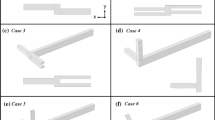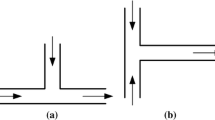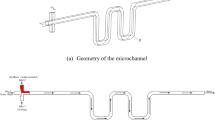Abstract
The mixing phenomena for two fluid streams in pressure-driven rectangular microchannels are analyzed and directly compared with the measurements of mixing intensity for a wide range of aspect ratio (width/depth = 1–20). In the analysis, the three-dimensional transport equation for species mixing was solved using the spectral method in a dimensionless fashion covering a large regime of the normalized downstream distance. The analysis reveals the details of non-uniform mixing process, which originates from the top and bottom walls of the channel and stretches out toward the center of the channel, and its transition to uniformity. Employing different length scales for the non-uniform and uniform mixing regimes, the growth of mixing intensity can be expressed in a simple relationship for various aspect ratios in the large range. The mixing experiments were carried out on silicon- and poly(methyl methacrylate) (PMMA)-based T-type micromixers utilizing fluids of pH indicator (in silicon channel) and fluorescent dye (in PMMA channel) to evaluate the mixing intensity based on flow visualization images. Using conventional microscopes, the experiments demonstrate the mixing intensity as a power law of the stream velocity for all the microfluidic channels tested. The variations of measured mixing intensity with the normalized downstream distance are found in favorable agreement with the numerical simulations. The comparison between the experiments and simulations tells the capabilities and limitations on the use of conventional microscopes to measure the mixing performance.










Similar content being viewed by others
References
Bird R, Stewart W, Lightfoot E (1960) Transport phenomena. Wiley, New York
Bottausci F, Mezic I, Meinhart CD, Cardonne C (2004) Mixing in the shear superposition micromixer: three-dimensional analysis. Philos Trans R Soc Lond A Math Phys Eng Sci 362:1001–1018
Branebjerg J, Gravesen P, Krog JP, Nielsen CR (1996) Fast mixing by lamination. In: Proceedings of the IEEE Micro Electro Mechanical Systems (MEMS), San Diego, USA, pp 441–446
Canuto C, Hussaini MY, Quarteroni A, Zang TA (1988) Spectral methods in fluid dynamics. Springer, Berlin Heidelberg New York
Chen Z, Gao Y, Su R, Li C, Lin J-M (2003) Fabrication and characterization of poly(methyl methacrylate) microchannel by in-situ polymerization method with novel metal template. Electrophoresis 24:3246–3252
Deval J, Tabeling P, Ho C-M (2002) A dielectrophoretic chaotic mixer. In: Proceedings of the IEEE Micro Electro Mechanical Systems (MEMS), Las Vegas, USA, pp 36–39
Gobby D, Angeli P, Gavriidis A (2001) Mixing characteristics of T-type microfluidic mixers. J Micromech Microeng 11:126–132
Gottlieb D, Orszag SA (1997) Numerical analysis of spectral methods: theory and applications. SIAM, Philadelphia
Horng R-H, Han P, Chen H-Y, Lin K-W, Tsai T-M, Zen J-M (2005) PMMA-based capillary electrophoresis electrochemical detection microchip fabrication. J Micromech Microeng 15:6–10
Ismagilov RF, Stroock AD, Kenis PJA and Whitesides GM, Stone HA (2000) Experimental and theoretical scaling laws for transverse diffusive broadening in two-phase laminar flows in microchannels. Appl Phys Lett 76:2376–2378
Kamholz AE, Yager P (2001) Theoretical analysis of molecular diffusion in pressure-driven laminar flow in microfluidic channels. Biophys J 80:155–160
Lee Y-K, Deval J, Tabeling P, Ho C-M (2001) Chaotic mixing in electrokinetically and pressure driven micro flows. In: Proceedings of the IEEE micro electro mechanical systems (MEMS), Interlaken, Switzerland, pp 483–486
Lide DR (1994) CRC handbook of chemistry and physics. CRC Press, Boca Raton
Liu RH, Stremler MA, Sharp KV, Olsen MG, Santiago JG, Adrian RJ, Aref H, Beebe DJ (2000) Passive mixing in a three-dimensional serpentine microchannel. J Microelectromech Syst 9:190–197
Lu R, Ryu K, Liu C (2002) A magnetic microstirrer and array for microfluidic mixing. J Microelectromech Syst 11:462–469
Nguyen N-T, Wu Z (2005) Micromixers—a review. J Micromech Microeng 15:R1–R16
Okkels F, Tabeling P (2004) Spatiotemporal resonances in mixing of open fluids. Phys Rev Lett 92(3):038301-1-4
Qu W, Mala GM, Li D (2000) Pressure-driven water flows in trapezoidal silicon microchannels. Int J Heat Mass Transf 43:353–364
Senturia SD (2001) Microsystem design. Kluwer, Boston
Stone HA, Stroock AD, Ajdari A (2004) Engineering flows in small devices: microfluidics toward a lab-on-a-chip. Annu Rev Fluid Mech 36:381–411
Stroock AD, Dertinger SKW, Ajdari A, Mezic I, Stone HA, Whitesides GM (2002) Chaotic mixer for microchannels. Science 295:647–651
Trefethen L (2000) Spectral methods in Matlab. SIAM, Philadelphia
White FM (1974) Viscous fluid flow. McGraw-Hill, New York
Wu Z, Nguyen N-T, Huang X (2004) Nonlinear diffusive mixing in microchannels: theory and experiments. J Micromech Microeng 14:604–611
Acknowledgments
The authors would like to thank the financial support for this study from the National Science Council of Taiwan under Contract Number NSC 92-2212-E005-012.
Author information
Authors and Affiliations
Corresponding author
Appendices
Appendix 1: Discretization with the Chebyshev polynomials
The concentration C(ξ, η, Z*) is approximated by a truncated double series of Chebyshev polynomials as
where T m (ξ) and T n (η) denote the Chebyshev polynomials and C mn the expansion coefficient. By choosing the Chebyshev Gauss-Lobato collocation points
we can form the following discrete transform/inverse transform
where \(d_{l}\,=\,\left\{ {\begin{array}{*{20}c} {{2},} & {{l\,=\,0,M},} \\ {{1},} & {{l\,=\,{\hbox{otherwise},}}} \\ \end{array} } \right.\) and \(e_{l}\,=\,\left\{ {\begin{array}{*{20}c} {{2},} & {{l\,=\,0,N},} \\ {{1},} & {{l\,=\,{\hbox{otherwise}}.}} \\ \end{array} } \right.\) This means that the truncated double series in Eqs. 21a, 21b will interpolate C(ξ, η, Z*) at the collocation points \({\left({\xi _{i}, \eta _{j} } \right)},\;i\,=\,0,1, \ldots, M,j\,=\,0,1, \ldots, N.\) Substituting Eqs. 21a, 21b into Eq. 19, C(ξ, η, Z*) can be further expressed as
where \(\phi _{i} (\xi){\text{ and }}\varphi _{j} (\eta)\) are the Lagrange interpolating polynomials defined as
The derivatives
and
can be obtained as
where \(\left[{{d\phi _{m} }}{\left({\xi _{i} } \right)}/{{d\xi }}\right]\,{\hbox{ and }}\,\left[{{d\varphi _{n} }}{\left({\eta _{j} } \right)}/{{d\eta }}\right]\) are usually denoted as the Chebyshev collocation derivative matrices formulated as
and likewise
The second derivative collocation matrices can then be obtained as
The boundary and initial conditions associated with the discretized equation are written as
The actual computations of these derivatives can be done alternatively by the transform and inverse transform in Eqs. 21a, 21b, which can speed up via FFT. The details are referred to Canuto et al. (1988) and Trefethen (2000).
Appendix 2: Rescaling the coordinates for parabolic velocity profile
For the channel with large γ, where the velocity is portrayed as a parabolic profile, Eq. 7a is rewritten as
where the downstream distance is rescaled as Z + = γ2 Z*=Dz/(h 2 u 0), in reference to the channel depth instead of the channel width, and the dimensionless width is in the small scale χ = γ X. Notably, Eq. 27 now does not contain γ, i.e. independent of aspect ratio. Equation 27 is then solved with the same boundary conditions of Eq. 7b for the concentration C(χ, Y, Z +) and the mixing intensity can be obtained by integrating C(χ, Y, Z +) over χ from the midline (χ = 0) to the outer limit (χ = ±δ/2h) of the concentration boundary layer,
or
where δ is taken as the dimensional width of interdiffusion region with a very small cutoff concentration (e.g. 1% or less). Then the product of I mix and γ given by Eq. 28b is independent of aspect ratio until δ becomes large enough to touch the sidewalls.
Rights and permissions
About this article
Cite this article
Chen, J.M., Horng, TL. & Tan, W.Y. Analysis and measurements of mixing in pressure-driven microchannel flow. Microfluid Nanofluid 2, 455–469 (2006). https://doi.org/10.1007/s10404-006-0092-9
Received:
Accepted:
Published:
Issue Date:
DOI: https://doi.org/10.1007/s10404-006-0092-9




